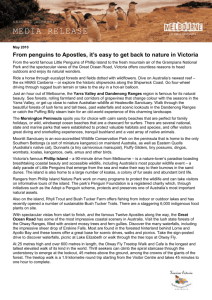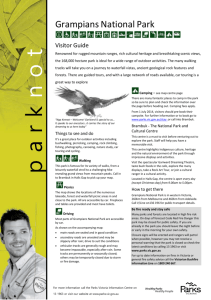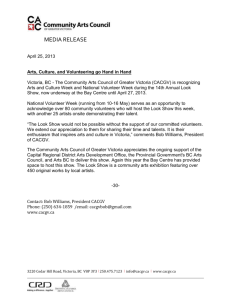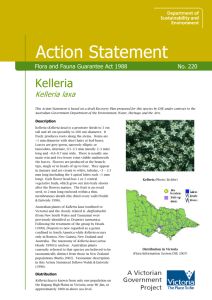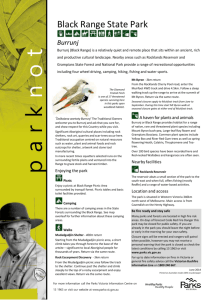Grampians Rice-flower (Pimelea pagophila) accessible
advertisement
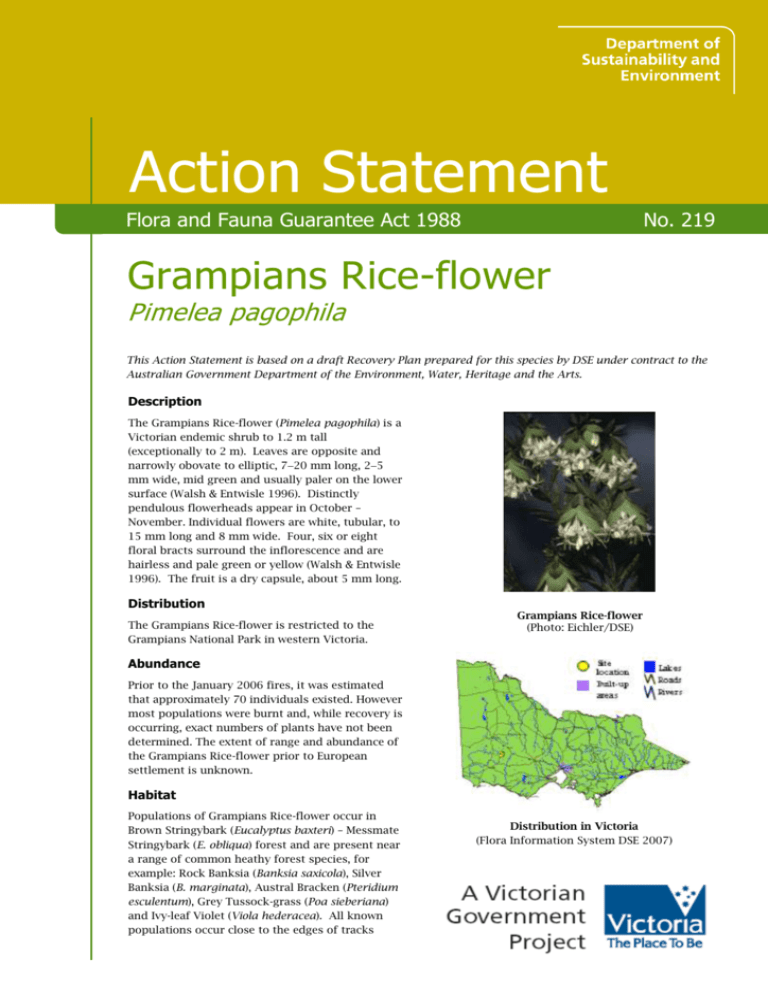
Action Statement Flora and Fauna Guarantee Act 1988 No. 219 Grampians Rice-flower Pimelea pagophila This Action Statement is based on a draft Recovery Plan prepared for this species by DSE under contract to the Australian Government Department of the Environment, Water, Heritage and the Arts. Description The Grampians Rice-flower (Pimelea pagophila) is a Victorian endemic shrub to 1.2 m tall (exceptionally to 2 m). Leaves are opposite and narrowly obovate to elliptic, 720 mm long, 25 mm wide, mid green and usually paler on the lower surface (Walsh & Entwisle 1996). Distinctly pendulous flowerheads appear in October – November. Individual flowers are white, tubular, to 15 mm long and 8 mm wide. Four, six or eight floral bracts surround the inflorescence and are hairless and pale green or yellow (Walsh & Entwisle 1996). The fruit is a dry capsule, about 5 mm long. Distribution The Grampians Rice-flower is restricted to the Grampians National Park in western Victoria. Grampians Rice-flower (Photo: Eichler/DSE) Abundance Prior to the January 2006 fires, it was estimated that approximately 70 individuals existed. However most populations were burnt and, while recovery is occurring, exact numbers of plants have not been determined. The extent of range and abundance of the Grampians Rice-flower prior to European settlement is unknown. Habitat Populations of Grampians Rice-flower occur in Brown Stringybark (Eucalyptus baxteri) – Messmate Stringybark (E. obliqua) forest and are present near a range of common heathy forest species, for example: Rock Banksia (Banksia saxicola), Silver Banksia (B. marginata), Austral Bracken (Pteridium esculentum), Grey Tussock-grass (Poa sieberiana) and Ivy-leaf Violet (Viola hederacea). All known populations occur close to the edges of tracks Distribution in Victoria (Flora Information System DSE 2007) (generally <10 m) or in more open habitat nearby. Soils are generally sandy. Important populations Important populations necessary to the long term survival and recovery of Grampians Rice-flower occur in the following locations: pollinators. Several Pimelea species appear to be more scented toward evening, suggesting that nocturnal moths may be more likely pollinators. Conservation status National conservation status Grampians National Park (managed by Parks Victoria): The Grampians Rice-flower is listed as ‘vulnerable’ under the Commonwealth Environment Protection and Biodiversity Conservation Act 1999. Victorian conservation status Logging Track north-west of Emmitts Track (previously ~62 plants but all were burnt in the 2006 Mt Lubra fire. Numbers are unknown and are due for survey in spring 2007). Mt William slope, 550m below Mt William carpark (previously 9 plants - some burnt, some scorched but recovering). Mt William Summit, about 300-500m above Mt William carpark of left side of road (1 plant after 2006 fire). Bomjimma walking track, between the carpark near the top of Mt William and the Bomjimma campground (recently discovered population – all plants burnt in 2006 and numbers unknown, but thought to be less than 20). 2nd Wannon Creek Track (all plants burnt, recovery occurring but numbers unknown) Sites not recently located within Grampians National Park: South-east slope of Major Mitchell Plateau, on a spur above Jimmy’s Creek (plants seen by walkers prior to the Jan 2006 fires. Location burnt out and not recently surveyed). Life history and ecology There have been no specific studies of the biology or ecology of Grampians Rice-flower. However, information on other Pimelea species may be usefully considered in relation to the Grampian Rice Flower in the absence of such specific data. The species is closely related to, for example, the Slender Rice-flower (P. linifolia). Morrison (2002) found the Slender Rice-flower to be more abundant in recently burnt areas of Sydney’s sandstone communities, than unburnt areas. Seedlings were seen at the ‘Mt William slope’ site in 2002, although the area had not been recently burnt. Germination may have occurred at that site after soil disturbance such as by herbivores or track works. Given the plants’ single-trunked habit, it is unlikely that it is a post-fire resprouter. The narrow tubular odourless flowers on various Pimelea species is a plant syndrome that suggests pollination by butterflies; however, casual observations by Hingston and McQuillan (2000) of Pimelea spp. in Tasmania did not detect those The Grampians Rice-flower has been listed as ‘threatened’ under the Victorian Flora and Fauna Guarantee Act 1988. It is considered ‘vulnerable’ in Victoria according to DSE’s Advisory List of Rare or Threatened Plants in Victoria – 2005 (DSE 2005). Potentially threatening processes Lack of biomass reduction Most Pimelea spp. resprout or recruit from seed after fire. The Grampians Rice Flower is also likely to require some disturbance to regenerate. Frequent fires All populations were affected by the January 2006 fires. Recovery is unknown. Road / Track maintenance Track widening, including clearing or slashing of vegetation would damage plants. Resprouting of damaged plants is not assured. A wide crane is proposed to drive to the summit of Mt William to remove a communications tower; this action would threaten two populations along that road. Land clearance is listed as a Key Threatening Process under the Commonwealth Environmental Protection and Biodiversity Conservation Act 1999. Cinnamon Fungus (Phytophthora cinnamomi) susceptibility Recent studies (Reiter et al. 2004) have shown that the Grampians Rice Flower is highly susceptible to the root pathogen Cinnamon Fungus (Phytophthora cinnamomi ). Spread of Cinnamon Fungus has been shown to be highly correlated with high levels of bushwalking or soil disturbance associated with road and track works. Grazing by native herbivores and/or pest animals Herbivore grazing of seedlings is known to have occurred in 2002. Increases in abundance of pest animals near Grampian Rice-flower populations may threaten plants. Herbicide Spraying Weeds spraying with herbicides at the 2nd Wannon Creek site is likely to have destroyed Grampians Rice-flower individuals. 2 Recreational 4WD / Trailbikes All plants of this species occur close to roads or tracks and are thus threatened by damage from recreational vehicles. Field searches were conducted with volunteer groups. Known populations were surveyed and information was collected on size and extent of these populations. A new population was discovered at Bomjimma track. Monitoring was undertaken following the January 2006 fire. Transects are established at Mt Williams and monitored every six months. All locations were monitored for Cinnamon Fungus following the January 2006 fires. Sites were treated for Cinnamon Fungus infestation as needed. Parks Victoria is commenced working on a Memorandum of Understanding for management of sites managed by water authorities. Liaison was undertaken with stakeholders including Parks Victoria, Wimmera Catchment Management Authority and the Statewide Threatened Flora Network. Accidental damage / Collection / Powerline works Plants along the road to the Mt William summit in particular are highly visible to tourists and recreational users, and flowers may be picked or plants damaged. Any works at a power-pole near one population may threaten individuals. Inappropriate biomass reduction / fire regimes Most Pimelea species demonstrate fire adaptations via resprouting or seeding. The Grampians Riceflower is likely to require some disturbance such as fire for recruitment. Future biomass management should consider the requirements of this species. Previous management action Seed has been collected and stored at the Royal Botanic Gardens. Surveys of suitable habitat have been undertaken. Conservation objectives, actions and targets Long term objective To ensure that the Grampians Rice-flower can survive, flourish and retain its potential for evolutionary development in the wild. Specific objectives, actions and targets The intended management actions listed below are further elaborated in DSE’s Actions for Biodiversity Conservation (ABC) system. Detailed information about the actions and locations, including priorities, is held in this system and will be provided annually to land managers and other authorities. Objective I To increase knowledge of biology, ecology and management requirements Action Targets Responsible 1. Acquire baseline population data by conducting detailed field and desk top surveys including identification of the area and extent of the population; estimates of the number, size and structure of the population; and inference or estimation of population change. Updated records on all state databases (FIS, VROTPop and Herbarium). DSE Parks Victoria Assess habitat characteristics and/or condition. Accurately survey known habitat, and collect and analyse floristic and environmental information relevant to community ecology and condition. Ecological requirements identified for the completion of essential life history stages, recruitment and dispersal. Conduct survey to locate suitable habitat. Identify and survey potential / historical habitat using ecological and bioclimatic information that may indicate habitat preference. Sites supporting potential habitat identified and surveyed. 2. 3. Populations accurately mapped. DSE Parks Victoria Core habitat mapped. DSE Parks Victoria 3 4. Undertake detailed population monitoring and collect demographic information. Continue to monitor populations affected by January 2006 fires, count plants and assess recovery. All populations counted and assessed. DSE, Parks Victoria 5. Identify disturbance regimes to maintain habitat or promote regeneration and recruitment. Knowledge of the Grampians Rice Flower’s vital attributes and ecological burning prescriptions will be key to developing future burn plans in all areas of the park where this species occurs. Fire response determined. DSE, Parks Victoria Undertake research to identify key biological functions. Evaluate current reproductive / regenerative status, seed bank status and longevity, fecundity and recruitment levels. Determine seed germination requirements by conducting laboratory and field trials aimed to identify key stimuli. Seed bank/regenerative potential quantified for target populations. Analyse population trends. Measure population trends and responses against recovery actions by collecting demographic information including recruitment and mortality, timing of life history stages and morphological data. Collate, analyse and report on census data and compare with management histories. Techniques for monitoring developed and implemented. 6. 7. Objective II Optimal ecological fire regime determined. Stimuli for recruitment/regeneration identified. DSE, Royal Botanic Gardens Management strategies identified to maintain, enhance or restore regenerative processes fundamental to reproduction and survival. DSE Census data for target populations. Population growth rates determined. Population Viability Analysis completed for targeted populations. To secure populations or habitat from potentially incompatible land use or catastrophic loss. Action Targets Responsible 8. Measurable seedling recruitment at Logging Track north-west of Emmitts Track, and Mt William slope sites. Parks Victoria Erect/maintain structures to restrict or discourage access. Control threats from pest animals, pathogens, predation, disturbance (park visitors and animals) and inappropriate management activities, by re-routing tracks and limiting access (fencing, caging plants). A measurable reduction in plant mortality at Logging Track north-west of Emmitts Track, Mt William summit, Mt William slope and 2nd Wannon Creek sites. Vehicular access to Logging Track north-west of Emmitts Track prevented. 9. Erect/maintain signs to restrict or discourage access. Control threats from disturbance (park visitors) by erecting appropriate signage. Measurable seedling recruitment at Logging Track north-west of Emmitts Track, and Mt William slope sites. Parks Victoria A measurable reduction in plant mortality at Logging Track north-west of Emmitts Track, Mt William summit, Mt William slope and 2nd Wannon Creek sites. Vehicular access to Logging Track north-west of Emmitts Track prevented. 4 10. Establish cultivated plants ex situ to safeguard from the unforeseen destruction of the wild population. Objective III Development of effective propagation and cultivation techniques. At least 20 mature plants in cultivation. DSE, Royal Botanic Gardens To improve the condition of habitat Action Targets Responsible 11. Manage environmental weeds. Control threats from pest plants by implementing appropriate methods of weed control (no broad scale spraying). Measurable seedling recruitment at Logging Track north-west of Emmitts Track, and Mt William slope sites. Parks Victoria 12. Manage plant pathogens. Control threats from pathogens by re-routing tracks and limiting access. Measurable seedling recruitment at Logging Track north-west of Emmitts Track, and Mt William slope sites. A measurable reduction in plant mortality at Logging Track north-west of Emmitts Track, Mt William summit, Mt William slope and 2nd Wannon Creek sites. Parks Victoria A measurable reduction in plant mortality at Logging Track north-west of Emmitts Track, Mt William summit, Mt William slope and 2nd Wannon Creek sites. 13. Control/reduce human disturbance. Control threats from disturbance (park visitors) and inappropriate management activities. Measurable seedling recruitment at Logging Track north-west of Emmitts Track, and Mt William slope sites. Parks Victoria A measurable reduction in plant mortality at Logging Track north-west of Emmitts Track, Mt William summit, Mt William slope and 2nd Wannon Creek sites. 14. Identify fire management priorities and develop detailed plan. Burn plans for the Grampians National Park are jointly developed and implemented by DSE (Fire Management) and Parks Victoria. DSE, Parks Victoria Knowledge of the Grampians Riceflower’s vital attributes and ecological burning prescriptions will be key to developing future burn plans in all areas of the park where this species occurs. Objective IV To increase the number of populations or individuals Action Targets Responsible 15. Store reproductive material. Establish a seed bank. Long-term storage facility identified. DSE, Parks Victoria, Royal Botanic Gardens 16. Determine seed viability. Seed viability determined. Seed from target populations in storage. Royal Botanic Gardens 5 Objective V To increase community awareness and support Action Targets Responsible 17. Involve community groups and volunteers in recovery activities. Opportunities for involvement identified, promoted and supported DSE References DSE (2005) Advisory List of Rare or Threatened Plants in Victoria – 2005. Department of Sustainability and Environment, East Melbourne, Victoria. Hingston, A.B & McQuillan (2000) Are pollination syndromes useful predictors of floral visitors in Tasmania?, Austral Ecology, 25; 600-609. Morrison, D.A. (2002) Effects of fire intensity on plant species composition of sandstone communities in the Sydney region, Austral Ecology, 27(4); 433-441. NSW NPWS (1993) Conservation Research Statement and Species Recovery Plan: Pimelea spicata, Unpublished report by the New South Wales National Parks and Wildlife Service (NSW NPWS), Hurstville. Reiter, N., Weste, G. & Guest, D. (2004) The risk of extinction resulting from disease caused by Phytophthora cinnamomi to endangered, vulnerable and rare species endemic to the Grampians, western Victoria. Australian Journal of Botany, 52; 425-433. Walsh, N.G. & Entwisle, T.J. (1996) Flora of Victoria Volume 3: Dicotoledons; Winteraceae to Mytaceae, Inkata Press, Melbourne. This Action Statement has been prepared under section 19 of the Flora and Fauna Guarantee Act 1988 under delegation from Mr Peter Harris, Secretary, Department of Sustainability and Environment, July 2008. Published by the Victorian Government Department of Sustainability and Environment Melbourne, July 2009 © The State of Victoria Department of Sustainability and Environment 2009 This publication is copyright. No part may be reproduced by any process except in accordance with the provisions of the Copyright Act 1968. Authorised by the Victorian Government, 8 Nicholson Street, East Melbourne. ISSN 1448-9902 For more information contact the DSE Customer Service Centre 136 186 Disclaimer This publication may be of assistance to you but the State of Victoria and its employees do not guarantee that the publication is without flaw of any kind or is wholly appropriate for your particular purposes and therefore disclaims all liability for any error, loss or other consequence which may arise from you relying on any information in this publication. Accessibility If you would like to receive this publication in an accessible format, such as large print or audio, please telephone 136 186, 1800 122 969 (TTY), or email customer.service@dse.vic.gov.au This document is also available in PDF format on the Internet at www.dse.vic.gov.au 6
